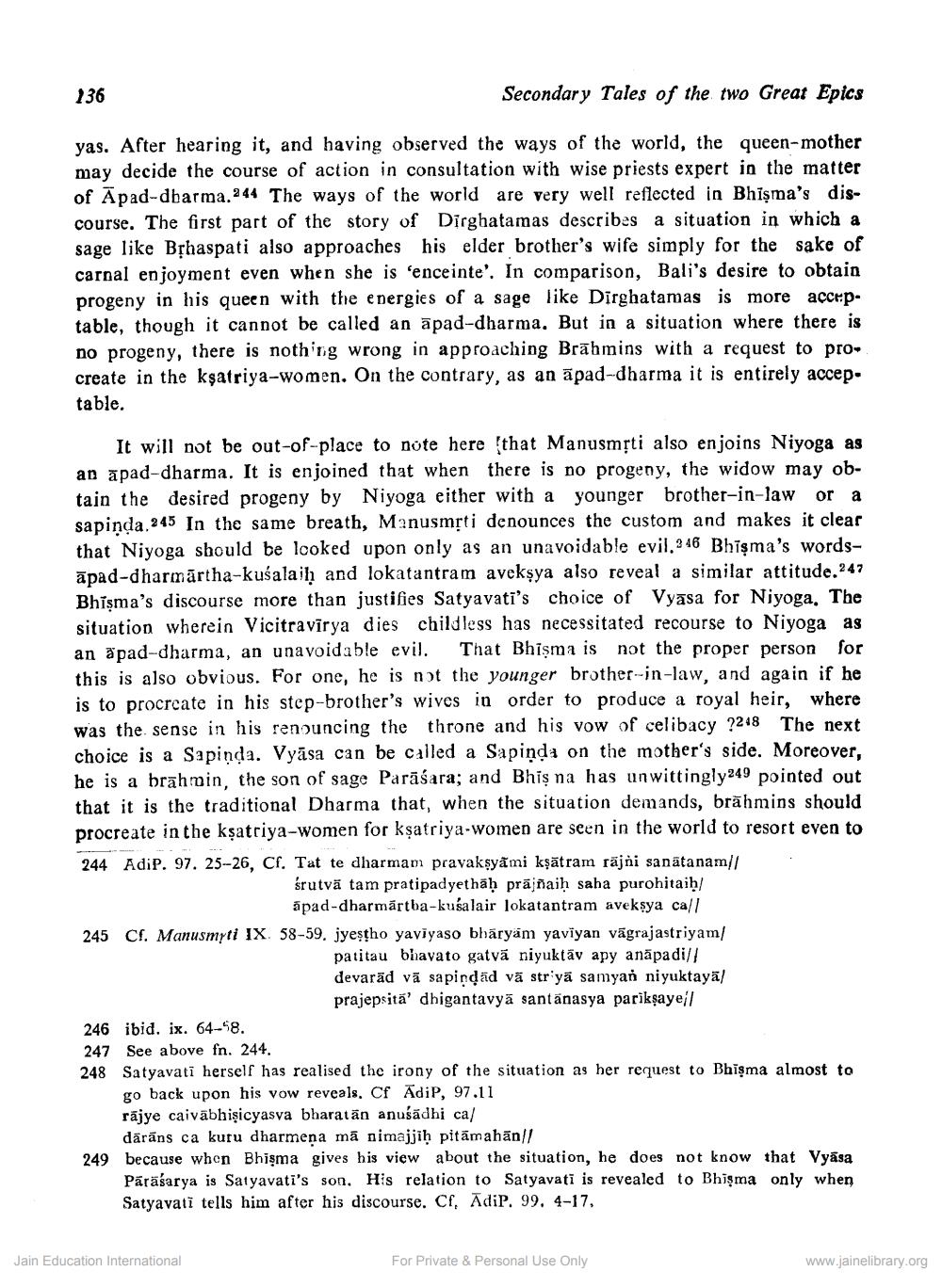________________
Secondary Tales of the two Great Epics
yas. After hearing it, and having observed the ways of the world, the queen-mother may decide the course of action in consultation with wise priests expert in the matter of Apad-dharma.44 The ways of the world are very well reflected in Bhisma's discourse. The first part of the story of Dirghatamas describes a situation in which a sage like Brhaspati also approaches his elder brother's wife simply for the sake of carnal enjoyment even when she is 'enceinte'. In comparison, Bali's desire to obtain progeny in his queen with the energies of a sage like Dirghatamas is more accep table, though it cannot be called an apad-dharma. But in a situation where there is no progeny, there is nothing wrong in approaching Brahmins with a request to pro create in the ksatriya-women. On the contrary, as an apad-dharma it is entirely accep
table.
136
It will not be out-of-place to note here that Manusmrti also enjoins Niyoga as an apad-dharma. It is enjoined that when there is no progeny, the widow may obtain the desired progeny by Niyoga either with a younger brother-in-law or a sapinda.245 In the same breath, Manusmrti denounces the custom and makes it clear. that Niyoga should be looked upon only as an unavoidable evil,248 Bhisma's wordsapad-dharmartha-kušalail and lokatantram avekşya also reveal a similar attitude.247 Bhisma's discourse more than justifies Satyavati's choice of Vyasa for Niyoga, The situation wherein Vicitravirya dies childless has necessitated recourse to Niyoga as an apad-dharma, an unavoidable evil. That Bhisma is not the proper person for this is also obvious. For one, he is not the younger brother-in-law, and again if he is to procreate in his step-brother's wives in order to produce a royal heir, where was the sense in his renouncing the throne and his vow of celibacy 7248 The next choice is a Sapinda. Vyasa can be called a Sapinda on the mother's side. Moreover, he is a brahmin, the son of sage Parāśara; and Bhis na has unwittingly249 pointed out that it is the traditional Dharma that, when the situation demands, brähmins should procreate in the ksatriya-women for ksatriya-women are seen in the world to resort even to 244 AdiP. 97. 25-26, Cf. Tat te dharmam pravakṣyami kṣātram rajni sanatanam// irutvā tam pratipadyethaḥ präjñaiḥ saha purohitaiḥ/ apad-dharmartba-kuśalair lokatantram avekṣya ca//
245 Cf. Manusmyti IX. 58-59, jyeṣṭho yaviyaso bharyam yaviyan vägrajastriyam/
patitau blavato gatvä niyuktav apy anapadi// devaräd va sapindad vā str ya samyan niyuktay/ prajepsita' dhigantavya santanasya parikşaye
246 ibid. ix. 64-58.
247 See above fn. 244.
248 Satyavati herself has realised the irony of the situation as her request to Bhisma almost to
go back upon his vow reveals. Cf AdiP, 97.11
rajye caivabhisicyasva bharatan anuidhi ca
dārāns ca kuru dharmeņa mā nimajjiḥ pitämahan//
249 because when Bhisma gives his view about the situation, he does not know that Vyasa Parasarya is Satyavati's son. His relation to Satyavati is revealed to Bhisma only when Satyavati tells him after his discourse. Cf, AdiP. 99. 4-17.
Jain Education International
For Private & Personal Use Only
www.jainelibrary.org




